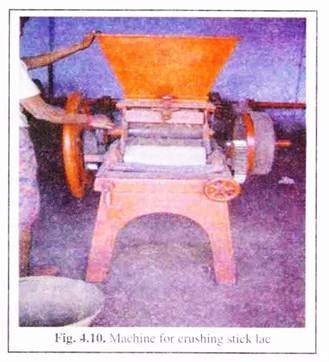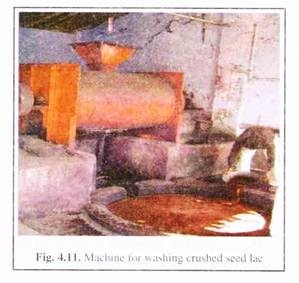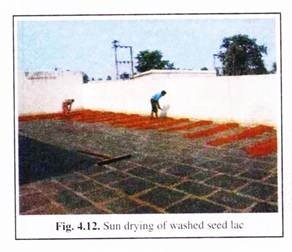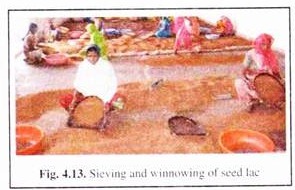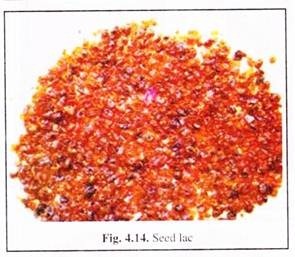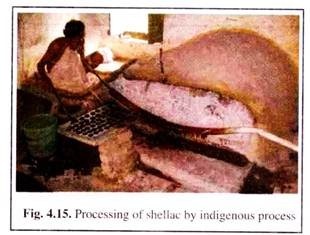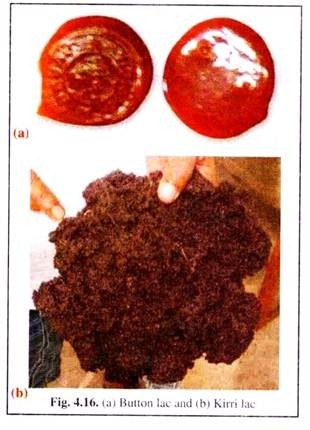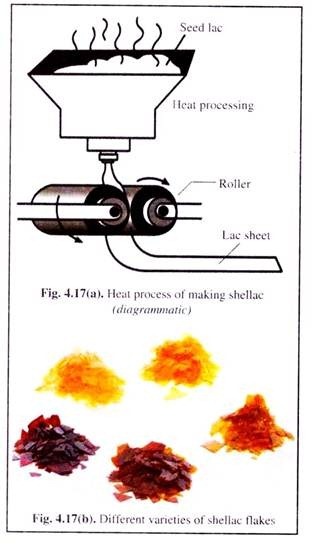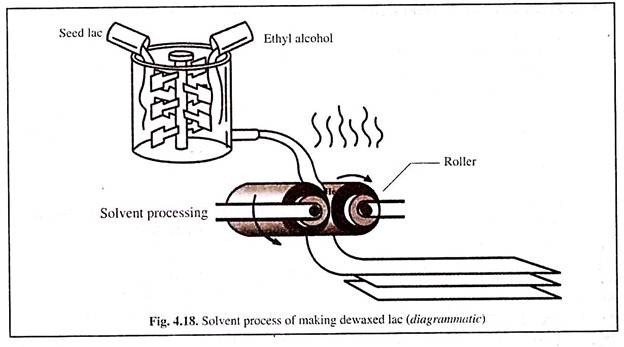The following points highlight the three main stages involved in processing of lac. The stages are: 1. Production of Stick Lac 2. Production of Seed Lac 3. Production of Shellac from Seed Lac.
Stage # 1. Production of Stick Lac:
During harvesting, the lac encrusted twigs are cut from the host plants. Then the lacs are removed from the twigs by scrapping. The lac thus obtained is known as stick lac or scrapped lac or crude lac or raw lac, that contains insect body, lac dye, sand and twig debris, in addition to resins.
If harvesting is done before emergence of larvae, then the lac obtained is referred to as Arilac. The stick lac, if required, can be stored on the floor in layers, less than 30 cm in height and racked frequently.
Stage # 2. Production of Seed Lac:
Stick lac, if stored for long time, may form lump due to its high moisture content and may invite other storage pests, and thereby causes substantial loss and deterioration in quality of desired industrial demands. So seed lac is produced from the stick lac by further processing.
ADVERTISEMENTS:
Stick lac is first crushed in a machine (Fig. 4.10) and sieved to remove sand and dust. Once the sieving is done the crushed stick lac is fed by basket into a Barrel Washing Machine (Fig. 4.11). The loading time taken is generally 15-20 minutes. Capacity of loading at a time of the barrel is its (diameter x length)/2.
This washing removes the dye from the sick lac and also removes other materials like sand, wood impurities and insect body. The process usually takes around two to three hours to complete. It uses a lot of water and the rotary device inside the barrel, helps the churning of the stick lac and helps in the cleaning process.
ADVERTISEMENTS:
The water that comes out of the barrel is often taken onto a field and is allowed to dry down. The contents are sometimes used as pesticides and fertilisers. However, the use is much restricted nowadays. The washing time and the methods adopted to do this improves the quality of the seed lac.
Different types of washing are done for different grades single wash for low quality, double wash for medium quality and triple wash for superior quality:
(a) Single Wash:
This involves simple washing without or with negligible amount of soda for some 45 minutes,
ADVERTISEMENTS:
(b) Double Wash:
Soda cleaning (750 gm for 500 kg) with low quantity of water for 20 minutes. Water is poured into the barrel from the top through pipe for about 25 minutes and stopped when colour of water passing through a 60 no. net at the back side of the barrel appears white,
(c) Triple Wash:
Water cleaning for 20 minutes. Soda washing (1 kg for 500 kg material) for 1 hour (superior quality) or 45 minutes (medium quality). Then again water cleaning for another 30 to 35 minutes. This is done till the water coming out of the barrel shows no pigment.
After the completion of washing, the bottom part of the barrel is opened and the total mass is poured into a circular cemented basin (size of the basin depends upon the capacity of the washer). The masses thereafter are filtered through cloth (different quality of cloth is used for different grade). After removing the lighter impurities (‘Khari’ or ‘Pati’) from the mass, seed lac is collected.
The seed lac is then spread into the open cement floor for drying (Fig. 4.12). The layer of seed lac is continuously rolled over the floor from one side to the other side with the help of a ‘Patri’ (a wooden flat strip having a long handle) for facilitating the drying.
The process of drying would take between an hour or two. Usually the washing should not go beyond 2 p.m. so that the finished product is dried by the end of the day.
After drying, the material is sieved through a number of Chaluni’ (circular hand operated sieving tools (Fig. 4.13). Each of them are of different size and helps sieve of the seed lac based on the size of the sieve. The residue so left out at this stage is called the ‘Kuni’ and ‘Molamma’.
ADVERTISEMENTS:
Then all materials so sorted out are gathered and remaining impurities are cleaned using the hand operated winnowing baskets (bamboo made instrument called ‘Kulo’) usually done by women.
The seed lac is obtained in the form of grain of 10 meshes or smaller, and yellow or reddish brown in colour (Fig. 4.14). Different grades of hand-made seed lacs are available in market like genuine Baisakhi, Fine baisakhi, Golden baisakhi. Golden Kusmi, Golden Kusmi-bold grain, Manbhum fine seedlac, etc.
Stage # 3. Production of Shellac from Seed Lac:
The lac most commonly used across the world is shellac which is produced by any of the following processes:
(a) Indigenous Process/Country Process:
In this traditional method, the seed lac is first filled into long sausage-shaped cloth bag of about 2 inches diameter and 30 feet length (Fig. 4.15). The bag is then gradually passed in front of a charcoal-fired hearth to melt the lac. By twisting the bag, the molted lac is then squeezed out through the sieve of the cloth.
This molten filtered mass is then either stretched into sheets of about 0.5 cm thick with the help of glazed ceramic cylinder, or allowed to solidify in form of dice, called button lac (Fig. 4.16a). The residue left inside the cloth bag contains apart from lac, sand, insect debris, and is referred to as kirrilac (Fig. 4.16b).
The shellac obtained by such method are available in various commercial forms like Lemon one shellac, Lemon two shellac, Superior shellac, Kusmi button lac, Light pure button lac, etc.
(b) Heat Process (Fig. 4.17):
In this process, the seed lac is melted by steam heat. Oxalic acid and titanium dioxide are mixed with the melted lac at this stage. The molten lac is then squeezed through filter by means of hydraulic pressures. The filtered molten lac is drawn into long and continuous sheets with the help of roller (Fig. 4.17a).
These sheets are broken into pieces, called flakes. Various grades of machine made shellac flakes are available commercially, that include Orange shellac, Black T.N. shellac, Orange fine shellac, (Fig. 4.17b), etc.
(c) Solvent Process:
In this process, the seed lac is dissolved in refrigerated alcohol and then filtered through filter press to remove the wax and other impurities (Fig. 4.18). The lac thus obtained is dewaxed lac. The alcohol is then removed with the help of roller; the molten shellac is then stretched.
The solvent process may yield various grades of commercial shellac, like Dewaxed platina, Dewaxed blonde, Dewaxed lemon, Dewaxed garnet, etc.
By the same process, decolourised lac can be obtained by removing the colour (to any required standard) through charging of the dissolved lac with activated carbon.
The basic procedure of bleached shellac manufacture includes following steps:
(1) Dissolving the shellac in aqueous sodium carbonate solution at 90-100°C;
(2) Stirring with sodium hypochlorite and
(3) Filtering after cooling.
The bleached shellac, thus obtained, is then reclaimed from the filtered solution with sulphuric acid. This bleached shellac is then again filtered and finally dried. The bleached lac is white in colour and commercially available in two grades, dewaxed bleached shellac and waxy bleached shellac.
